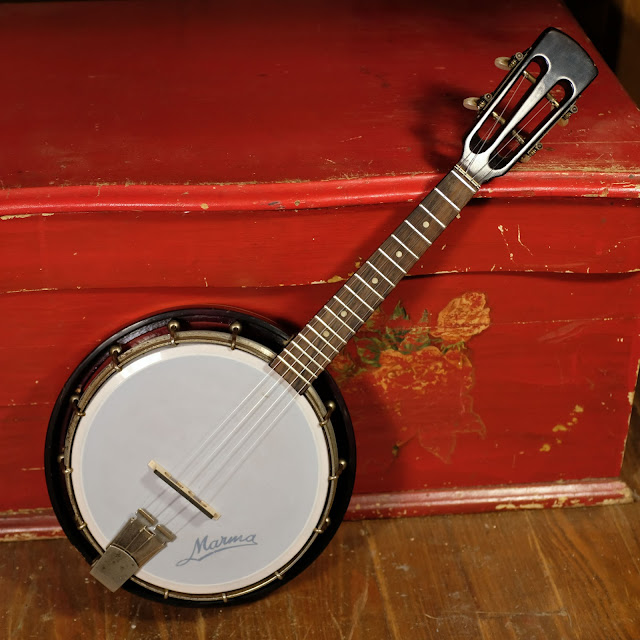1960s East German-made Marma Resonator Banjo Ukulele
I have to admit that when I heard about this instrument on the phone I wasn't too excited. I've worked on Marma banjo-mandolins in the past and they've been funky and fun, but sometimes the build quality on these East German instruments can be really finicky. Out of the shipping box, however, I got to see just how cool this is.
Aside from the (presumably replacement) tailpiece and bridge, it's all-original and even still has its drum-style synthetic head with the original branding on it. At 8 3/4" diameter, the rim is even larger than the "big-size" rims of 8" American instruments and the resonator brings it to a full 10 5/8" on the back. The neck is a narrow 1 1/8" at the nut and has a C/V shape with a modern mandolin feel to it -- it's fast. One wonders if this was intended to fill the need for a 4-string banjo-mandolin (banjolin/melody banjo) and banjo-uke in the "crowded" DDR communist "market."
When this came in, the instrument was covered in several layers of grunge and had tons of spray-paint speckles all over it. It was a bit of a pain to clean, but after that mild trauma, the rest of the work was straightforward. It got a fret level/dress, tuner lube, new bridge install, and various rim adjustments. This has a coordinator rod setup on the inside of the rim and an archtop tonering design. Both of these are plusses in my book and the tonering definitely gives this thing a big forward punch and oodles of volume. This would be fun in a jam! It now plays perfectly and is strung with Martin fluorocarbon strings.
Who doesn't love a nicely-sculpted slotted headstock on a banjo-uke? That's cool. The three-ply plastic nut is a dead giveaway of German design and so is the zero fret. Because I gave these frets a level/dress, the zero fret is now a nice bonus rather than a drag.
They're often (as in the case of this instrument beforehand) originally installed with an oversize fretwire rather than wire that matches the rest of the frets and that destroys any semblance of a good setup at the nut from the factory.
The board is rosewood and the rim and neck are some sort of maple-like material.
The spiffy tuners use a design style straight out of the late 1800s. You can find tuners like these on German instruments from both sides of the border well into the late '60s and early '70s.












Comments
Do I have to remove every screw...?